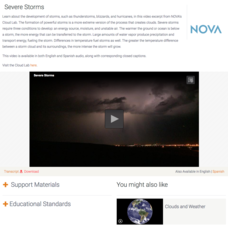PBS
Severe Storms
Approximately 2,000 thunderstorms happen simultaneously across the planet at any given time—that's a lot! Beginning with how clouds form, NOVA describes the conditions needed for storms to develop, and highlights the three factors that...
Howard Hughes Medical Institute
Anole Lizards: An Example of Speciation
What happens to a species when members become separated by changes in their environment? Present young biologists with the ultimate example species—the anole lizard. A brief video describes the origins of the multitude of anole species...
Howard Hughes Medical Institute
Development of the Cerebral Cortex
How do the many parts of our brains form as we grow and develop? Peer inside a developing brain using a short video. Topics include stem cells, differentiation, and the unusual way these specialized neurons organize themselves throughout...
Howard Hughes Medical Institute
Autism and the Structure and Function of Synapses
Take autism awareness in your class to a whole new level. Scholars watch a short video to discover how autism affects the brain. The narrator discusses the effects of altered proteins on neural synapses and the role the nucleus plays in...
Howard Hughes Medical Institute
Cancer and Cell Fate in the Intestinal Epithelium
What happens when intestinal epithelia receive the wrong directions during differentiation? Discover how tumors form in the intestinal lining using a narrated video. The resource shows both normal and cancerous growth using specially...
Howard Hughes Medical Institute
How We Get Our Skin Color
Is our skin color determined only by genetics? Explore skin science through a video and related interactive. Young biologists discover the cells of the epidermis, how melanin is made, and the factors that influence the outward appearance...
Howard Hughes Medical Institute
Termite Activity Enhances Ecosystem Productivity and Stability
Termites in your house? Bad. Termites in your garden ... good? Discover the good side of an insect that often gets a bad rap with an interesting animation. The narrator discusses how termites break down plant material, what the soil...
Howard Hughes Medical Institute
Gorongosa's Water Cycle
Gorongosa National Park holds a fascinating and ever-changing landscape. What makes the water cycle in the park so special? Travel to Mozambique to learn more about the park using a short video. Content includes rainy season in the park,...
TED-Ed
Why Some Countries Are Poor and Others Rich
It's a question economists, anthropologists, and sociologists have asked themselves since the first regional lines were drawn in the sand. Are there common factors that destine one country to thrive and another to struggle? An...
Howard Hughes Medical Institute
Differentiation and the Fate of Cells
Did you realize cells become restricted in the types of cells they produce as embryos develop? Stem cells might become anything, but late state cells can only become the specialized cell based on their locations. A captivating video does...
PBS
The Climate Wild Card
If Earth didn't have clouds, the global temperature would be at least 22 degrees Fahrenheit warmer. Viewers examine the importance of clouds on temperature, climate, and global warming. The video describes the current impact of clouds...
PBS
Why So Many Cloud Types?
Scientists categorize clouds by both height and shape since both traits impact the weather independently. Viewers fly high to learn about the characteristics of each type of cloud. NOVA explains the composition of clouds, the atmospheric...
PBS
The Coriolis Effect Due to Earth's Rotation
Why do big storms spin as they travel? As Earth spins, the movement of air and water change. Viewers observe the Coriolis effect on paper airplanes, water, and even hurricanes—and find the effect is everywhere!
TED-Ed
How Does Hibernation Work?
Did you know animals hibernate all around the world, even in the deserts and tropical rain forests? How do these animals reach extreme body temperatures and undergo a decreased heart rate that would be deadly to non-hibernating animals?...
PBS
Biogeography: Where Life Lives
Biogeography is the study of the geographical distribution of plants and animals. NOVA's Evolution Lab explains how organisms on different continents can be so closely related. The resource discusses the processes that bring life from...
PBS
Evolution 101
Have you been shaped by evolution? A short video introduces the idea of evolution through examples of natural selection, reproduction, traits, and more. The video exists as a small part of a series from the NOVA Evolution Lab.















